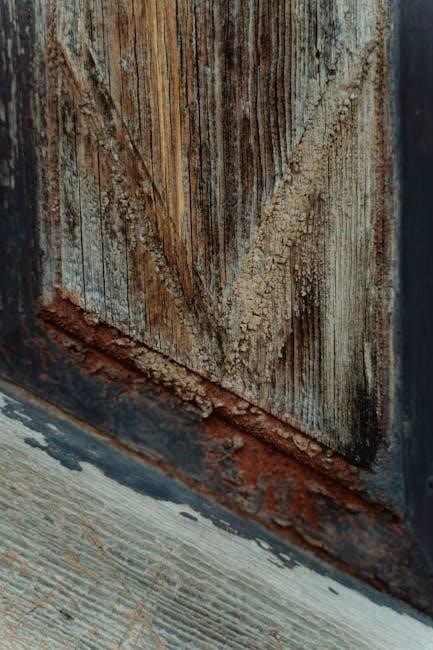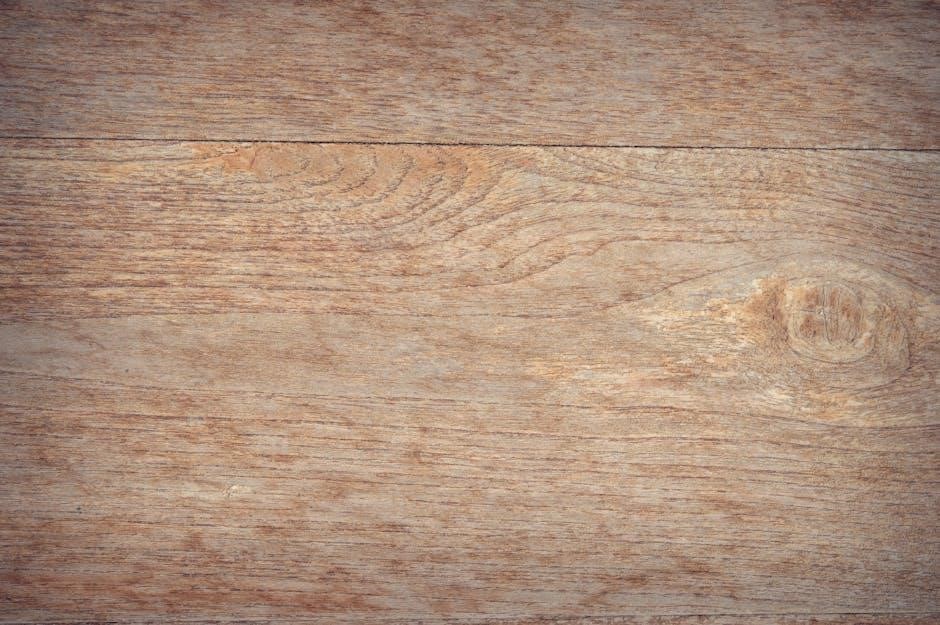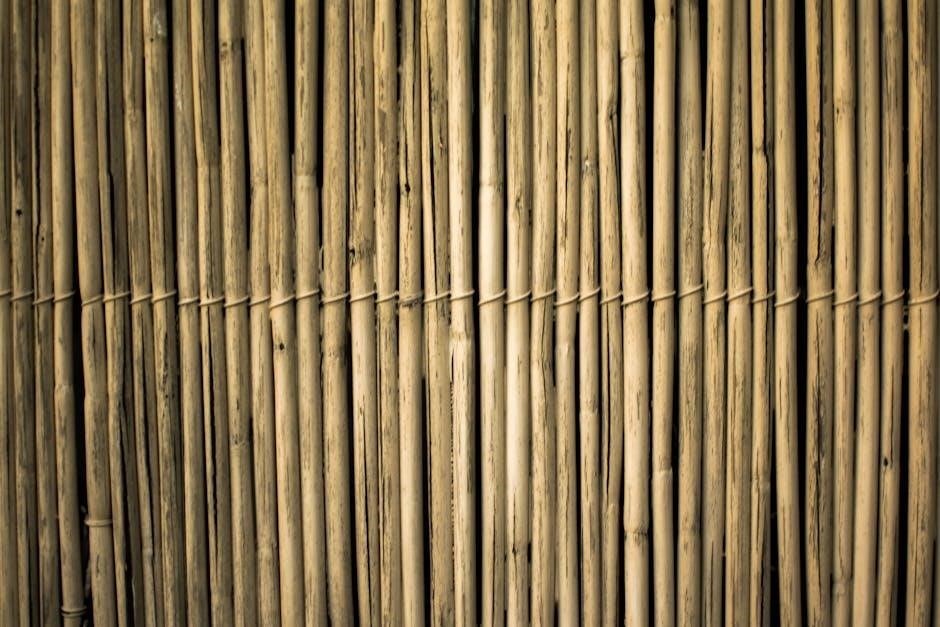Discover the essentials of timber sleeper retaining wall design, exploring its benefits, construction tips, and key considerations for creating durable, visually appealing structures to enhance outdoor spaces effectively.
Overview of Retaining Walls and Their Importance
Retaining walls are structures designed to hold back soil and prevent erosion, creating level areas for landscaping, driveways, and outdoor spaces. They are essential for managing slopes, stabilizing ground, and preventing water pressure damage. By reshaping terrain, retaining walls enhance property functionality and aesthetics, while ensuring long-term structural integrity; Their importance lies in their ability to control land movement, protect against soil degradation, and provide stable foundations for various outdoor projects, making them a vital element in modern construction and landscaping.
Why Choose Timber Sleepers for Retaining Walls?
Timber sleepers are a popular choice for retaining walls due to their cost-effectiveness, ease of installation, and natural aesthetic appeal. They are durable, versatile, and can be tailored to fit various design preferences. Sleepers are also lightweight, making them easier to handle during construction. With proper treatment, they offer long-term resistance to rot and pests, ensuring structural integrity. Their ability to blend seamlessly into outdoor environments while providing functional support makes timber sleepers an ideal option for homeowners and landscapers seeking a practical yet visually pleasing solution.
Understanding the Basics of Timber Sleeper Retaining Walls
Timber sleeper retaining walls are durable, versatile structures that use treated wood to hold back soil and create level spaces. They are strong, cost-effective, and long-lasting when properly constructed.
What Are Timber Sleepers?
Timber sleepers are rectangular beams of wood, often treated with preservatives for durability, used in construction projects like retaining walls. They can be new or reclaimed, offering versatility and strength. Sleepers provide a cost-effective, eco-friendly solution for landscaping, with treated pine being a popular choice for outdoor structures due to its resistance to rot and pests. Regular maintenance ensures longevity, making them a practical option for retaining walls and other applications requiring stability and aesthetic appeal.
Types of Timber Sleepers for Retaining Walls
Timber sleepers for retaining walls come in various types, including treated pine, hardwood, and reclaimed options. Treated pine sleepers are durable and resistant to rot, making them ideal for outdoor use. Hardwood sleepers, like railway sleepers, offer exceptional strength and longevity. Reclaimed sleepers provide a rustic aesthetic and are eco-friendly; The choice depends on budget, desired appearance, and structural requirements. Thicker sleepers, such as 2.4x50mm or 1.8x75mm, are recommended for taller walls to ensure stability and withstand soil pressure effectively.
Advantages and Disadvantages of Timber Sleeper Walls
Timber sleeper walls are cost-effective, easy to install, and offer a natural aesthetic appeal. They are lightweight, making them ideal for DIY projects, and can be tailored to various designs. However, they require periodic maintenance to prevent rot and pest damage. Treated pine sleepers are durable but may leach chemicals. Untreated options have a shorter lifespan. While they are versatile, they may not be suitable for very tall walls without additional support. Regular upkeep is essential to ensure longevity and structural integrity.
Materials and Tools Required
Essential materials include treated timber sleepers, posts, and screws. Tools needed are drills, saws, shovels, and spirit levels. Drainage materials and concrete for the foundation are also required.
Essential Materials for Construction
Treated timber sleepers are the primary material, offering durability and rot resistance. Posts for vertical support and screws for secure connections are vital. Drainage materials like gravel and geotextile fabric prevent water damage. Concrete is needed for the foundation to ensure stability. Fasteners, such as coach bolts, add strength. Weather-resistant wood screws are ideal for assembling sleeper panels. A spirit level ensures proper alignment, while a shovel aids in site preparation. Optional materials include decorative caps for a polished look and sealants for added protection. Safety gear like gloves and goggles is also recommended.
Tools Needed for Building a Timber Sleeper Wall
A drill and impact wrench are essential for driving screws and bolts. A shovel is necessary for digging the foundation, while a spirit level ensures alignment. A saw is required for cutting sleepers to size, and a measuring tape aids in precise layouts. A post hole digger helps create holes for vertical posts. A concrete mixer or trowel is needed for laying the foundation. Sandpaper can smooth rough edges, and a hammer may assist with fitting parts together. Safety gear like gloves and goggles is crucial for protecting yourself during construction.
Design Considerations for Timber Sleeper Retaining Walls
Key factors include wall height, sleeper thickness, and drainage. Adequate gravel and a sturdy foundation ensure stability. Proper design prevents water pressure and structural failure over time.
Factors Influencing Wall Design
The design of timber sleeper retaining walls is influenced by soil type, wall height, and expected load. The thickness and length of sleepers, drainage requirements, and foundation depth are critical. Treated timber is essential for durability, while proper alignment and leveling ensure structural integrity. The choice of fasteners, such as coach bolts, impacts strength. Local building codes and budget constraints also play a role in determining the final design specifications for a safe and functional retaining wall.
Calculating the Height and Width of the Wall
To determine the height and width of a timber sleeper retaining wall, consider the slope and required leveling. The wall’s height is dictated by the land’s gradient and the need to create a level area. For stability, ensure at least one-third of the sleeper’s height is buried underground. The width, or thickness, is typically determined by the sleeper size, such as 200x50x6Mts, providing adequate strength. Proper drainage and soil type are also crucial factors in these calculations to ensure structural integrity and prevent water pressure issues.
Drainage and Water Management
Effective drainage is crucial to prevent water pressure buildup behind the wall. Install gravel behind the sleepers to allow water to drain freely. Consider adding a drainage pipe to redirect water away. Ensure the ground slopes slightly away from the wall to prevent water accumulation. Proper drainage prevents structural damage and extends the wall’s lifespan, especially in areas with heavy rainfall or clay soils.
Structural Integrity and Reinforcement
Ensuring structural integrity is vital for the longevity of timber sleeper retaining walls. Use coach bolts or steel rods to secure sleepers together, providing added strength. Thicker sleepers, such as 1.8 x 75mm treated pine, offer greater durability. For taller walls, consider additional reinforcement like steel posts or brackets. Proper weight distribution and a solid foundation are essential to prevent shifting or collapse. Height restrictions apply; walls exceeding 1.5m may require professional engineering advice to ensure safety and compliance with local building codes;

Planning and Preparation
Assess the site, obtain necessary permits, and prepare the area by clearing debris and leveling the ground. Proper drainage and gravel base are crucial for stability and longevity.
Site Assessment and Planning
Begin by assessing the site conditions, including soil type, drainage, and slope. Ensure the area is level and clear of debris. Measure the space accurately to determine the required length and height of the wall. Check local regulations and obtain necessary permits before starting construction. Proper planning ensures the wall is functional, stable, and compliant with safety standards. Mark out the area clearly to guide the building process. Consider drainage solutions to prevent water buildup, which is crucial for the wall’s longevity and structural integrity.
Obtaining Necessary Permits
Before starting your timber sleeper retaining wall project, it’s crucial to obtain all necessary permits. Check with your local council or planning department to ensure compliance with building codes and regulations. Depending on the wall’s height and location, you may need engineering plans or approvals. Failure to secure permits can result in fines or removal of the structure. Ensure your design meets local standards and submit all required documentation to avoid legal issues and ensure a smooth construction process.
Preparing the Site for Construction
Clear the site of debris, vegetation, and obstructions. Level the ground to ensure a stable base for your timber sleeper wall. Mark the area with stakes and string to define the wall’s boundaries. Check for underground utilities to avoid damage. Excavate the footing trench to the required depth, ensuring it’s even and compacted. Lay a base layer of compacted gravel for drainage and stability. This preparation ensures a solid foundation for your retaining wall, preventing future structural issues and water damage.
Construction Steps
Lay sleepers horizontally, securing them with coach bolts. Ensure proper alignment and level. Backfill with gravel, compacting layers for stability and drainage efficiency. Build in stages.
Step-by-Step Guide to Building the Wall
Begin by preparing materials, ensuring sleepers are treated for durability. Dig a trench for the foundation, leveling the ground. Lay the first sleeper, anchoring it securely. Stack subsequent sleepers, aligning edges and drilling holes for coach bolts. Tighten bolts firmly to maintain structural integrity. Backfill with gravel, compacting layers to prevent shifting. Repeat until the desired height is reached, finishing with a decorative cap if desired. Ensure drainage holes are included to manage water effectively.
Laying the Foundation
Laying the foundation is critical for stability. Dig a trench slightly wider than the sleepers, ensuring the base is level and compact. Fill with compacted gravel or concrete for a solid base. Place the first sleeper, aligning it with the trench edges. Secure it using anchor bolts or spikes. Ensure the foundation is level and evenly supported to distribute weight evenly. Proper drainage, such as a gravel layer, should be added to prevent water accumulation. This step ensures the wall’s structural integrity and long-term durability.
Assembling the Sleeper Panels
Assemble sleeper panels by stacking sleepers horizontally, ensuring even spacing and alignment. Secure them with coach bolts or screws, spaced 1-2 meters apart for stability. Vertical posts should be anchored to the foundation and attached to the sleepers for added strength. Ensure the panels are level and plumb, checking alignment at each course. Proper drainage should be integrated, such as leaving gaps between sleepers or adding a perforated pipe. This step ensures the wall’s structural integrity and prepares it for backfilling. Regular maintenance will extend the lifespan of the panels.
Securing the Sleepers with Fasteners
Securing sleepers with fasteners is crucial for stability and durability. Use coach bolts or high-strength screws, spaced every 1-2 meters, ensuring alignment for even distribution of weight. Vertical posts should be anchored deep into the ground and attached securely to the sleepers. Properly tightened fasteners prevent shifting and enhance structural integrity. Ensure drainage is maintained to prevent water pressure buildup behind the wall, which can weaken the structure over time. Regular inspection of fasteners ensures long-term reliability and safety.

Backfilling and Landscaping
Backfilling involves filling the space behind the wall with gravel and soil to ensure proper drainage. Landscaping enhances aesthetics with plants and finishes, completing the structure seamlessly.
Backfilling the Wall
Backfilling is a critical step after constructing the timber sleeper wall. It involves filling the space behind the wall with a mix of gravel and soil to ensure stability. Start by placing a layer of compacted gravel to improve drainage and prevent waterlogged soil. Then, fill the remaining area with topsoil, ensuring it is level and firmly packed; Proper backfilling helps distribute the earth’s pressure evenly, enhancing the wall’s structural integrity and longevity. This step is essential for both functionality and aesthetic appeal.
Landscaping and Finishing Touches
After backfilling, focus on landscaping to blend the wall seamlessly into your outdoor space. Plant shrubs, flowers, or grasses along the top and sides for a natural look. Add decorative gravel or mulch to enhance aesthetics and prevent weeds; Consider installing seating, lighting, or pathways to create a functional and inviting area. Finally, apply a wood stain or sealant to protect the timber and maintain its appearance. These finishing touches not only beautify the space but also ensure the wall remains a durable and eye-catching feature for years to come.
Maintenance and Longevity
Regular upkeep ensures timber sleeper walls remain durable and visually appealing. Inspect for damage, clean debris, and reapply treatments as needed to prolong their lifespan effectively.
Regular Maintenance Tips
Regular maintenance is crucial for extending the lifespan of timber sleeper walls. Inspect the structure annually for signs of damage or rot, and address issues promptly. Clean debris from the wall and surrounding areas to prevent moisture buildup. Treat the timber with protective sealants or preservatives to shield it from rot and insect damage. Ensure proper drainage by checking gravel backfill and drains. Trim nearby vegetation to avoid root interference. Regularly tighten any loose fasteners and replace damaged sleepers as needed. These steps ensure the wall remains stable and visually appealing for years.
Extending the Lifespan of the Wall
To extend the lifespan of a timber sleeper wall, use treated or durable hardwoods to resist rot and insects. Ensure proper drainage by installing a gravel backfill and drainage system to prevent water pressure. Regularly inspect and replace any damaged or rotten sleepers promptly. Apply protective sealants or preservatives to shield the timber from environmental factors. Maintain a strong foundation and ensure the wall is level to prevent shifting. These practices will help safeguard the structure and ensure long-term stability and aesthetic appeal.
Budgeting and Cost Considerations
Budgeting for a timber sleeper wall involves considering sleeper size, material type, and design complexity. Larger sleepers and treated materials increase costs but enhance durability and longevity.
Estimating Costs for Materials and Labor
Estimating costs for timber sleeper retaining walls involves calculating material expenses, including sleepers, fasteners, and concrete, and labor costs for construction. Prices vary based on wall size, material quality, and location. On average, treated pine sleepers range from $10 to $30 per meter, while labor costs can add $50 to $100 per meter, depending on complexity. Obtaining quotes from suppliers and contractors is essential for accurate budgeting. Plan for additional expenses like drainage materials and potential engineering fees for taller walls. Always include a 10-15% contingency for unforeseen costs to ensure your project stays within budget.
Cost-Effective Design Strategies
To create a cost-effective timber sleeper retaining wall, optimize dimensions and use standard sleeper sizes. Treated pine sleepers are a budget-friendly option, offering durability at a lower cost. Minimize cutting by designing the wall to fit standard sleeper lengths. Use drainage materials efficiently to prevent water damage. Consider a simple design to reduce labor costs. Plan for future maintenance to extend the wall’s lifespan. By balancing material quality, design simplicity, and practical construction methods, you can achieve a functional and aesthetically pleasing wall without exceeding your budget.
Comparing Timber Sleeper Walls with Other Materials
Timber sleeper walls offer a cost-effective, visually appealing alternative to concrete or brick, combining durability with natural aesthetics for versatile landscaping solutions.
Timber vs. Concrete vs. Brick Retaining Walls
Timber sleeper walls are cost-effective and visually appealing, while concrete walls offer superior strength and longevity. Brick walls provide durability and an attractive finish but are more expensive. Timber sleepers are ideal for DIY projects and natural aesthetics, whereas concrete is better for heavy-duty applications. Brick walls require skilled labor but offer timeless beauty. Each material has unique advantages, making the choice dependent on budget, durability needs, and desired visual appeal for your retaining wall project.
Choosing the Best Material for Your Project
Selecting the right material for your retaining wall depends on budget, durability, and aesthetic preferences. Timber sleepers are cost-effective and offer a natural, rustic appearance, making them ideal for DIY projects and garden landscapes. Concrete is durable and low-maintenance, suitable for heavy-duty applications. Brick provides a classic, timeless look but is more expensive and labor-intensive. Consider factors like weather resistance, structural needs, and long-term maintenance when deciding between timber, concrete, or brick for your retaining wall project.

Safety Guidelines and Precautions
Always wear protective gear, ensure stable structures, and follow proper lifting techniques to prevent injuries. Plan for drainage and monitor water pressure to avoid wall failure during construction.
Safety Measures During Construction
Safety is crucial when building timber sleeper retaining walls. Always wear protective gear, including gloves, safety glasses, and a hard hat. Ensure the structure is stable before working near it. Use proper lifting techniques to avoid injuries. Plan for adequate drainage and monitor water pressure to prevent wall failure. Keep tools and materials organized to avoid tripping hazards. Never overload the wall during construction. Ensure the site is clear of debris and follow all local safety regulations. Regular inspections and adherence to guidelines ensure a durable and safe structure.
Preventing Accidents and Injuries
Preventing accidents during timber sleeper retaining wall construction requires careful planning and adherence to safety protocols. Always wear protective gear, including gloves, safety glasses, and a hard hat. Ensure the site is well-lit and free from tripping hazards. Use proper lifting techniques to avoid strain injuries. Never work under unstable structures or overloaded sections. Regularly inspect tools and materials for damage. Maintain clear communication with team members to avoid collisions. Follow local safety regulations and consider professional guidance for complex projects to ensure a safe working environment and durable structure.
Timber sleeper retaining walls offer a cost-effective, visually appealing solution for outdoor spaces. Proper construction and maintenance ensure longevity, making them a durable and sustainable choice for landscaping projects.
Final Thoughts on Timber Sleeper Retaining Wall Design
Timber sleeper retaining walls are a cost-effective and visually appealing solution for landscaping projects. They offer durability and aesthetic charm when properly designed and maintained. Key considerations include using treated pine for longevity, ensuring adequate drainage, and selecting the right sleeper thickness for structural integrity; Regular maintenance, such as inspecting for rot and ensuring proper drainage, is essential to extend the wall’s lifespan. With careful planning and execution, timber sleeper walls can enhance outdoor spaces while providing functional support for years to come.